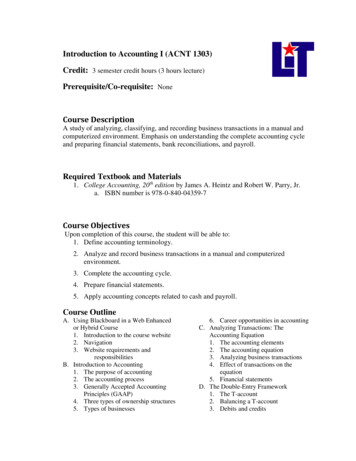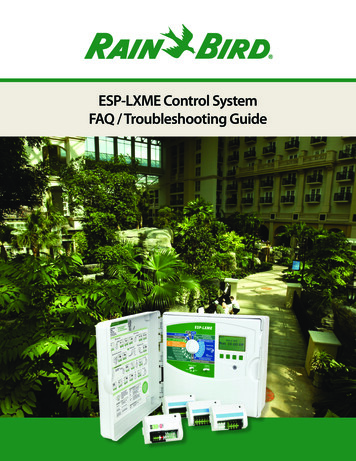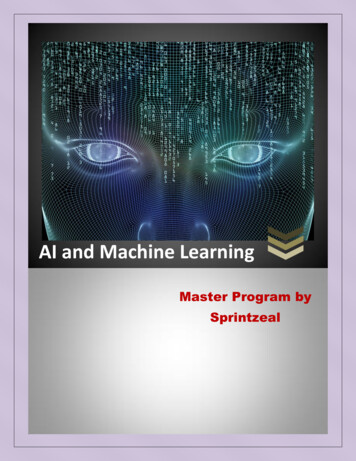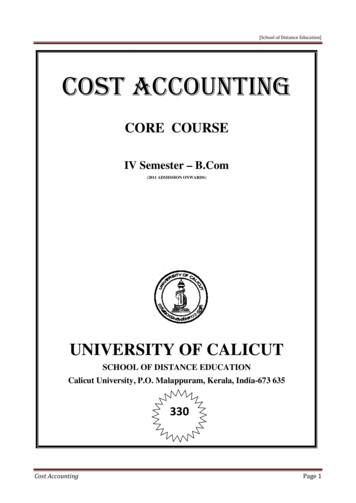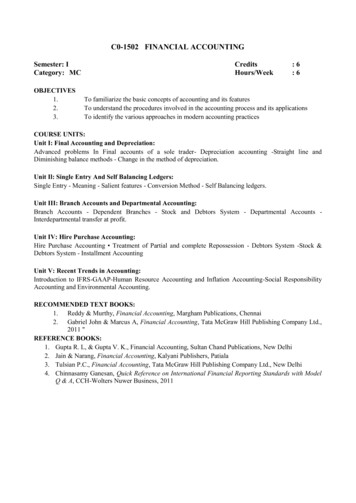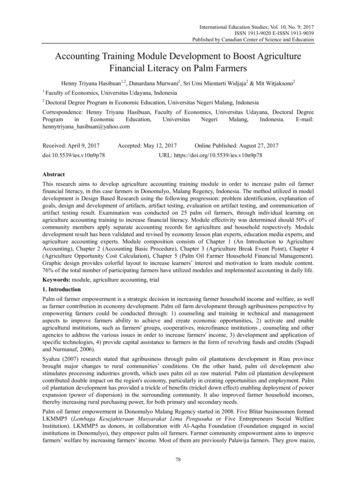
Transcription
International Education Studies; Vol. 10, No. 9; 2017ISSN 1913-9020 E-ISSN 1913-9039Published by Canadian Center of Science and EducationAccounting Training Module Development to Boost AgricultureFinancial Literacy on Palm FarmersHenny Triyana Hasibuan1,2, Danardana Murwani2, Sri Umi Mientarti Widjaja2 & Mit Witjaksono21Faculty of Economics, Universitas Udayana, Indonesia2Doctoral Degree Program in Economic Education, Universitas Negeri Malang, IndonesiaCorrespondence: Henny Triyana Hasibuan, Faculty of Economics, Universitas Udayana, Doctoral Malang,Indonesia.E-mail:hennytriyana hasibuan@yahoo.comReceived: April 9, 2017doi:10.5539/ies.v10n9p78Accepted: May 12, 2017Online Published: August 27, 2017URL: https://doi.org/10.5539/ies.v10n9p78AbstractThis research aims to develop agriculture accounting training module in order to increase palm oil farmerfinancial literacy, in this case farmers in Donomulyo, Malang Regency, Indonesia. The method utilized in modeldevelopment is Design Based Research using the following progression: problem identification, explanation ofgoals, design and development of artifacts, artifact testing, evaluation on artifact testing, and communication ofartifact testing result. Examination was conducted on 25 palm oil farmers, through individual learning onagriculture accounting training to increase financial literacy. Module effectivity was determined should 50% ofcommunity members apply separate accounting records for agriculture and household respectively. Moduledevelopment result has been validated and revised by economy lesson plan experts, education media experts, andagriculture accounting experts. Module composition consists of Chapter 1 (An Introduction to AgricultureAccounting), Chapter 2 (Accounting Basic Procedure), Chapter 3 (Agriculture Break Event Point), Chapter 4(Agriculture Opportunity Cost Calculation), Chapter 5 (Palm Oil Farmer Household Financial Management).Graphic design provides colorful layout to increase learners’ interest and motivation to learn module content.76% of the total number of participating farmers have utilized modules and implemented accounting in daily life.Keywords: module, agriculture accounting, trial1. IntroductionPalm oil farmer empowerment is a strategic decision in increasing farmer household income and welfare, as wellas farmer contribution in economy development. Palm oil farm development through agribusiness perspective byempowering farmers could be conducted through: 1) counseling and training in technical and managementaspects to improve farmers ability to achieve and create economic opportunities, 2) activate and enableagricultural institutions, such as farmers' groups, cooperatives, microfinance institutions , counseling and otheragencies to address the various issues in order to increase farmers' income, 3) development and application ofspecific technologies, 4) provide capital assistance to farmers in the form of revolving funds and credits (Supadiand Nurmanaf, 2006).Syahza (2007) research stated that agribusiness through palm oil plantations development in Riau provincebrought major changes to rural communities’ conditions. On the other hand, palm oil development alsostimulates processing industries growth, which uses palm oil as raw material. Palm oil plantation developmentcontributed double impact on the region's economy, particularly in creating opportunities and employment. Palmoil plantation development has provided a trickle of benefits (trickel down effect) enabling deployment of powerexpansion (power of dispersion) in the surrounding community. It also improved farmer household incomes,thereby increasing rural purchasing power, for both primary and secondary needs.Palm oil farmer empowerment in Donomulyo Malang Regency started in 2008. Five Blitar businessmen formedLKMMP5 (Lembaga Kesejahteraan Masyarakat Lima Pengusaha or Five Entrepreneurs Social WelfareInstitution). LKMMP5 as donors, in collaboration with Al-Aqsha Foundation (Foundation engaged in socialinstitutions in Donomulyo), they empower palm oil farmers. Farmer community empowerment aims to improvefarmers’ welfare by increasing farmers’ income. Most of them are previously Palawija farmers. They grow maize,78
ies.ccsenet.orgInternational Education StudiesVol. 10, No. 9; 2017cassava, and other palawija plant. Income generated from cassava and maize yield could not make ends meet infarmers household. Therefore a lot of farmers are encouraged to participate in farmer empowerment program.LKMMP5 distributes seeds, fertilizer and money to be used by farmers through Al-Aqsha Foundation. Theyhave been conducting it for three tears straight without compensation. Forementioned funding is ZIS (ZakatInfak and Shodakoh) LKMMP5 fund. Al Aqsha Foundation acts as the Agricultural Counselor (PPL). Highquality seed comes from Balai Benih Sawit (Palm Seed Institution) in Medan. Two factoryion seeds weredistributed to farmers in Donomulyo Malang as initial stage. Each farmer obtained seedlings equal to theirrespective lands to be planted with palm oil. As long as palm oil tree has not yielded, the farmers could plantcorn or cassava as crop intercropping. Fourth year after plantation in Donomulyo, the plants began to produceTBS (Tandan Buah Segar or Fresh Fruit Bunches).Donomulyo region possess 268 palm oil farmers managed by 25 group leaders. Each group leaders guidedifferent number of farmers under them. South Donomulyo TBS fare better compared to North Donomulyo TBS.Nearly every palm oil farmer in South Donomulyo gain support from PPL (Penyuluh Pertanian Lapangan orAgriculture Counselor), LKMMP5 and group leaders. A large number of family members in this region areformer TKI (Tenaga Kerja Indonesia or Indonesian Labor Force) who worked in Malaysian Palm Oil Plantation.Support and TKI experience resulted in better palm oil yield in South Donomulyo compared to NorthDonomulyo.Donomulyo palm oil farmer empowerment, as stated by Al-Aqsha Foundation administrator, is consideredsuccessful due to the following facts: (1) Palm oil trees could grow on Donomulyo soil (2) Palm trees planted inDonomulyo region could bear fruit and yield similar result to Sumatra plantation (3) TBS yields are directlymarketed to South Blitar near Donomulyo borders namely PT Sawit Harum Madani as palm oil processingfactory (4) Community suspicion regarding palm oil damage to environment, especially lack of clean watersources was not proven (5) Increase in palm oil farmer society revenue. (6) Prices set by PT Sawit HarumMadani (palm oil processing factory near Donomulyo) are set on the same price (entire yield regardless of palmoil age) and has no effect should palm oil value fluctuates, and not to cause discord among farmers (7) Entirecost of TBS freight is not charged to farmers but to PT Sawit Harum Madani instead. Genenova (2014) researchtitled empowerment failure of palm oil farmer in Wambers village, Karoom Regency Papua. High freight onharvested yield was imposed on palm oil farmer instead of palm oil processing factory. Palm oil farmer refusedto harvest their palm oil field due to imposed freight cost, despite palm trees having yielded fruit.Palm oil farmers could benefit from palm oil yield for 25 years, with proper care and maintenance. To achievemaximum benefit, farmers require additional cost such as fertilizer, pest extermination, labor force, andequipment procurement cost. The highest cost among those additional costs is fertilizing procedure which isconducted every three months. There are few farmers who do not fertilize their palm oil field regularly thereforeit does not produce optimally. These farmers claim for not possessing enough funds to procure fertilizer. Thereare also farmers who are tempted to substitute palm oil trees with sengon. Despite so, substituting palm trees tosengon trees require large amount of money which includes sengon seedling procurement and palm tree fielddemolizing.Farmer community low education level influenced their behavior which inversely proportional to their welfare.In order to increase welfare, palm oil farmers are expected to take a role as themselves and manager. As amanager, farmers are required to understand how to utilize various production factors such as field, labor, andcapital effectively in order to obtain maximum profit.Most of palm oil farmers in Donomulyo do not perform agriculture accounting. This behavior is caused byfarmers’ behavior which includes low level of knowledge, attitude, and skills on agriculture accounting. Despiteexisting farmers groups in Donomulyo, counseling programs have not covered financial management andaccounting. Most of farmers do not conducting accounting. They only recall real cost on their respectiveagriculture activities by memory. Despite so, after thorough financial examination these farmers experiencemonetary loss. Not every cost was accounted by the farmers such as household labor providing a hand inagriculture activity. These labor forces are not paid. Nevertheless their efforts had to be accounted for.This indicates agriculture accounting is considered unimportant. Nevertheless by conducting proper agricultureaccounting in accordance with guidance, the farmers would be capable of managing their agriculture financewell and therefore would be able to expand their business. According to Susanti (2013) accounting application isparallel to financial literacy. It means by applying accounting in their daily life, it would increase their financialliteracy. Ester (2012) explains research result regarding accounting training in Hutumuti Leitimur Village inAmbon. The researcher concluded that participants’ knowledge on accounting has increased after agriculture79
ies.ccsenet.orgInternationnal Education StuudiesVol. 10, No. 9; 2017financial aaccounting training as much as 92.31%.Based on rresearch backgground above, existing researrch problem iddentified in Doonomulyo palmm oil farmers area asfollows: (11) Most of pallm oil farmer ccommunity doo not conduct ccash income aand outcome acccounting (2) Palmoil farmerr are incapablee of accountinng profit/loss generated froom their incomme (3) Palm ooil farmers doo notunderstandd opportunity costc applicatioon (4) Palm oiil farmer do noot understand hhow to managge and expand theirbusiness frrom obtained profit/loss.pFore menttioned problemms caused staagnancy in faarmer welfare; therefore aggriculture accoounting traininng isrequired.2. MethoddThe researrch method utilizeduis Dessign Based Reesearch (DBRR) approach, wwhich is a flexxible method. Theresearcherrs collaboratedd with Al-Aqssha Foundation from initiall step of moddule developmment program. Trialsubjects arre male palm oil farmer undder Al-Aqsha Foundation guuidance who hhas been receiving ZIS fundds forthree conssecutive years from 2008. GGroup examinaation was connducted on 8 ((eight) palm ooil farmers. Onn theother handd, field examinnation was connducted on 255 (twenty five)) palm oil farmmers. Suparmaan (1977) provvidessample limmitation on fieeld examinatioon subjects foor 10-30 peopple. Data analyysis was condducted throughh thefollowing process: moddule creation, mmodule testingg, and modulee revision. Percentage analyysis techniquee wasutilized too measure modul prototype accuracy. Thhis technique is conducted in order to exxamine number oflearned coommunity memmbers (in perccentage) capabble of performming separate accounting foor agribusinesss andhouseholdd in daily life. Analysis ressult utilizing ppercentage annalysis are desscribed as folllows: 0-25% (lesseffective), 26% -50% (quuite effectivelyy), 51% -75% (effective) andd 76% -100% (very effectivee)2.1 Study DDesignDesign-Baased Researchh application in agriculturee financial litteracy developpment and immplementation wasadapted froom Model 6-PPhase developeed by Peffers eet al. (2007, as quoted in Ellyy & Levy, 20100).Figure 1. RResearch proceedure2.2 Researrch ProcedureIn each staage of development, findingss of a preliminnary study are ppresented, as wwell as developpment results, earlyproduct tesst, final producct test and the final module rrevision.3. Results3.1 Probleem Identificatioon PhaseProblem iddentification phasepand commmunity educattion level (palmm oil farmer) is Elementary School (SD) 36%,Secondaryy (44%), High school (16%) and Bachelor Degree graduaate (4%). Palmm oil farmer agge ranges aboutt 30 60 years. Under 40 yeaars (4%), 40-50 years (84%)) and above 550 years (12%). Residents ppossess another jobaside as oiil palm farmerrs, namely; (444%) as a laboreer, (24%) maizze and cassavaa farmer, (16%%) stock farmerr and(16%) other occupation. Income earneed by communnity is Rp 1,0000,000 to Rp 22,000,000 (64%%). Palm oil faarmercommunityy empowermeent has manageed to increase their income but it is inverrsely proportioonal farmer weelfarelevel. Onee factor causinng this issue iss large numbeer of participannts did not appply accountinng in everydayy life.Data colleected communiity needs and study materiall, which in turrn exhibits the following ressult: (1) 84% ofo thelearners reequires a module on agricullture accountinng applicationn in daily life (2) 80% of thhe learners reqquiresmaterial onn Break Eventt Point profit/loss calculationn (3) 72% of thhe learners reqquires opportuunity cost studyy andaccountingg (4) 100% ofo learners reqquires materialls on househoold financial mmanagement. The results of theproblem iddentification arre described inn following Figgure 2.80
ies.ccsenet.orgInternationnal Education StuudiesVol. 10, No. 9; 2017Fiigure 2. Probleem identificatioon process3.2 Explaiining Module DevelopmentDGGoal PhaseIn formulaating book keeeping traininng modules too improve financial literacyy, researchers,, teams of exxperts(validator)), facilitators anda learners (ppalm oil farmerr) collaboratess by means of Focus Group Discussion (FGD).FGD identtified agricultuure accountingg training moduules to improvve financial liteeracy. The purrpose of agricuultureaccountingg training moddule design is ddescribed in thhe following prrocesses:a.Describing modulee formulation aim is based on first phasee requirement. Training material is focuseed onpracttical applicatioons, method, aand selected teechnique has tto avoid technniques which ppromote transffer ofknowwledge from facilitators to paarticipants (Lunnandi, in Sunhhaji, 2013).b.Moduules are provided using parrticipative learrning method, module usagee guidance is inserted insidde, aswell as agribusiness related practtice questions aand answer keyys.c.Moduule stresses onn group discusssion. Adult eduucation is conducted throughh discussion, wwhether in smaall orlarge groups (Lunanndi in Sunhaji, 2013).3.3 Modulle Design and DevelopmentDPPhasePreparing agriculture accounting moduule draft in ordder to increasee financial literracy was based on Robert GagneG(in Nasutiion, 1997) edducation theoryy which is deescribed as foollows: Gaininng Attention, Inform learneer ofObjectivess, Stimulate recallrof priorr learning, Prresent stimuluus material, PProvide learneer guidance, ElicitEPerformannce, Provide Feeedback and AAssess Feedbacck, Enhance rettention transfeer.Design annd developmeent process iss conducted bby researcherss along with group collabboration (Al-AAqshaFoundationn Board) in thhe following acctivities: prepaaration of moddule preliminarry content, prepparation of moodulecontent maaterial, and moodule drafting. Module is titlled as follows: Accounting TTraining Moduule to Increase Palm81
ies.ccsenet.orgInternational Education StudiesVol. 10, No. 9; 2017Oil Farmer Financial Literacy. The structure of the module introduction section consists of (1) background toprovide brief explanation regarding interconnection of each chapter in the module; module characteristics,advantages, and strength (2) Module usage requirement which contains prerequisites before user learn to use themodules (3) general purpose of modules which provide information on module objectives to be achieved bylearners (4) instructions on module usage to participants and facilitators in using the module (5) Evaluation andassessment, which provides information on how to complete tasks and exercises in the modules. Main part of themodule consists of: (1) Chapter 1 discusses introduction to agriculture accounting (2) Chapter 2 discussesaccounting fundamentals and applications procedures (3) Chapter 3 discusses agriculture Break Event Point, (4)Chapter 4 discusses agriculture Opportunity Cost and (5) Chapter 5 discusses palm oil farmers householdfinancial management. Each chapter contains basic competencies, indicators to be achieved, Content, Summary,Evaluation / problems in practice section, assessment criteria and Answer Key. Exercises vary each chapterstarting from description, calculation, and multiple choices. Total score for each examination section is 100.Subject mastery is classified as follows: 67-100 is good category, 40-66 is adequate and s 0-39 is poor. The finalpart of the module is the Glossary and Resource Referral.Module was validated prior to examination process. Agriculture accounting training validation examinationprocess was conducted by economy learning plan, education media, and agriculture accounting experts. Validatorteam for economy learning and education media experts are professors of Universitas Negeri Malang. On theother hand, validator for agriculture accounting experts is practioners in agriculture accounting field. Modulevalidation result exhibits that module is feasible to be examined.3.4 Trial Evaluation PhaseTrial evaluation on agriculture accounting training in order to improve financial literacy was conducted in twosteps, which are described as follows:1) On Learning ProcessCash book accounting and financial report organizing learning process resulted in average grade of 50.36(adequate category). Trained community members obtaining poor is 16%. These people possess elementaryeducation level and are above 50 years old. Break Even Point (BEP) learning process resulted in averagegrade of 59.8 (adequate category). Poor category is 8% for those with elementary education level and areabove 50 years old.Opportunity cost and calculating opportunity cost learning process resulted in average grade of 67.56%(good category).Palm oil farmer household financial management learning process with multiple choice utilized indetermining trained community member literacy resulted in average grade of 68 (good category). Averagegrade for overall trained community members is 61.43% which is in adequate category. Learning processresult indicates that agriculture accounting training module is effective to be utilized in agricultureaccounting training.2) Trial Result of Separate Accounting Application to Trained Community Member on Agriculture andHousehold in Daily ActivityEvaluation monitoring in accounting application conducted by trained community members in their dailyactivity was performed three times. Researcher used patrol model (Sayuti, 2010). Patrol model on learningprocess result measurement is a form of learning process evaluation. A facilitator as evaluator conductobservation on trained community member progress.On first monitoring evaluation, 52% trained community member did not apply accounting in their dailyactivity, while 40% have applied accounting in daily activity despite having to go through revision process,8% of trained community members have applied accounting in daily ativity with little revisions.On second monitoring evaluation, 36% of trained community member have not applied accounting inagribusiness and daily activity. 56% have applied accounting in daily activity with revisions. 8% communitymembers have applied accounting in daily activity with little revision.On third monitoring evaluation, 24% trained community members have not applied accounting in dailyactivity. 76% have applied accounting. From the forementioned 76%, 8% of them have applied accountingin their daily activity properly, 32% have appled accounting in daily life with little revision, and 36% ofthem have applied accounting in daily life with guidance required due to revisions performed.3) Observer (Collaboration Team) Response to Agriculture Accounting Traning82
ies.ccsenet.orgInternational Education StudiesVol. 10, No. 9; 2017Monitoring result on agribusiness accounting training by collaboration team (Al-Aqsha Foundation) exhibitsvery good process and produced 87.5% result. Lerning process, facilitator performance, participants, andfacilitator technique.Ellis and Levy (2010) states evaluation procedure is an indirect observation which is conducted to complementdirect observation result and measuring quantitatively module appropriateness for the community members. It isalso in accordance with Design Based Research characteristics in measuring qualitative and quantitativeintegrated research. Based on tryout, 76% of trained community members have applied separate bookkeepingbetween agriculture and household activity. This fact indicates that module is proven to be very effective asagribusiness accounting training media in endeavor to improve financial literacy. Trial analysis exhibitsquantitative module and very effective therefore it is appropriate as education media for community membersand their characteristic. Research result is parallel to Aisyah et al. (2011) that module usage could improvelearner cognitive strategy.Questionnaire test result aimed at community members to module content exhibits that 87% claimed thatagribusiness accounting module is easy to understand.3.5 Communication of Product Revision PhaseAgriculture accounting training module has gained success in trial process with palm oil farmer in DonomulyoMalang Regency as test subjects. It is considered effective to be utilized. Empyrical findings have beendiscussed above; few research findings implications to andragogy application in economy education innon-formal education. Obstacles experienced during this process are described as follows:a.Trained community members who do not apply accounting in their daily activity is caused by loweducation level factor, aged at 50 years old or above. Therefore it is difficult for them to receive newinformation. They do not wish to add work load by applying accounting. Offered solution is providingblack boards, board markers and erasers to record cash income and outcome in their respective households.In doing so it would enable other family members to provide aid in accounting processes and enable themto adapt over time as well as experience benefit from accounting.b.Trained community members who have applied accounting in agriculture and household activities yet stillexperience mistakes. Researcher and collaboration team cooperate in providing guidance to improve theirbook keeping and in accordance with SAK ETAP guidance SAK ETAP (Standar Akuntansi KeuanganEkuitas Tanpa Akuntabilitas Publik or Financial Equity Accounting Standard without PublicAccountability).c.Lack of capital issue for each fertilizer purchase faced by the farmers. Offered solution is by deductingpalm oil harvest yield to purchase fertilizer. In the future, Al Aqsha Foundation could establish savings andloan cooperation as a bridge to capital issue faced by farmers.4. DiscussionThis research has been successfully conducted through few phases. Each phases influences learning processresult. On problem identification phase, informations related with participating community members are:education level, age, and number of household members, revenue level from palm oil, and other occupationother than palm oil farmer. In module formulation, factors under consideration are as follows: (1) Who are thecommunity members? (2) How do these community members behave? (3) How prepared are these communitymembers to study? And (4) How motivated are the community members or other characteristics that couldcontribute to their learning process?. Most of the participating community members (84%) are elementary school(Sekolah Dasar) and middle school or SLTP (Sekolah Lanjutan Tingkat Pertama) graduates. Participatingcommunity members aged above 40 is an obstacle in this training. Applied learning strategy is adult learningprocess by employing participative education, non-formal, with learning process conducted in local agriculturecommunity. Andragogy core doctrine states that education is not merely transfer of knowledge from teacher tostudent, it is a learning process activity aimed at problem solving (Freire, 1985)Objective description phase is conducted by explaining modules according to problem identification result.Therefore module objective explanation which states accounting application in daily activity for bothagribusiness and household could improve financial literacy.Design and development phase is a real activity phase conducted by arranging module draft. This module wasarranged in five chapters. Module design was adapted according to existing farmer in Indonesia who possess lowlevel of education, therefore module design have to be simple and interesting suited to their needs.83
ies.ccsenet.orgInternational Education StudiesVol. 10, No. 9; 2017Trial result exhibits 76% trained community members have applied accounting in their daily activity; thereforethey have improved their financial literacy. (McRae, 1997 in Manurung, 2013) Financial literacy is one of bridgethat forms prosperous family. Accounting application has been realized by applying accounting in daily activityand control monthly outcome. As much as 24% of trained community members do not apply accounting due totheir inability to understand accounting during training process. Low education level and old age of 50 years oldor above are factors which caused their difficulty in receiving new information (Anang et al., 2004). One ofbehavior which inhibits andragogy learning process is difficulty in accepting change.Communication phase is a phase for module to be communicated with users, which are community members andfacilitator. In this phase, module is known to have fulfilled the involved parties need (community members andfacilitator). Therefore module development process have fulfilled requirements as stated by Plomp et al. (2007)that module have to be developed according to user need.5. Conclusion and Suggestion5.1 ConclusionBased on research result, there were several findings from research and development perspective, as well asdeveloped product perspective stated as Product Development Strength and Weakness (Kekuatan dan KelemahanProduk Pengembangan). Agriculture accounting training module to increase financial literacy strength andweakness is described as follows:The following are few instances that could be considered developed product strength1)Interesting for trained community members as it is suited to their needs. Therefore this module motivatesthem to study and apply accounting in their daily activity.2)Agriculture accounting training module product to improve financial literacy is relevant with farmers needsespecially palm oil farmers.3)Agriculture accounting training module product uses simple accounting in order to enable farmersunderstanding and applying accounting in their daily activity easily.4)This development product has been valicated by three experts in their respective fields: economy educationplan, economy education media, and agriculture accounting. This module have been through trial process inparticipating community members. Modules contain figures, illustrations, and color variations which sparkslearner interest.5)Practice questions and key answers relevant to real conditions therefore making it interesting forparticipating community members to study it.6)Module components are focused on agriculture accounting complemented with basic competency formula,achievement indicator, study guidance, and syllabus.The following are few instances that could be considered as module weakness:1) Community members participated in training are not disciplined in learning process. They undergo guidancein solving practice question.2) Lack of facilities such as books, study room, and others rendered learning process ineffective.3) Agriculture accounting module to improve financial literacy was not complemented with education mediasuch as video and audio, therefore community members have to be more active in seeking out othereducation sources4) Limited test subject, module were tested on palm oil farmers for the first time in Malang Regency as trialproject in empowering palm oil farmers.5) Time limitation in learning process application monitoring and evaluation in trained community members’daily activity. Therefore application result has not been recorded optimally.5.2 Application Suggestion, Disemination, and Further Product Developmenta.Application SuggestionSuggestion provided to agriculture accounting module product users for community members, facilitatorsand every education force, either formal or non-formal forces, in applying this module is as follows:1) Science and Technology (IPTEK) benefit for community in learning this module is by independentlyconduct accounting for both agribusiness and household activity.84
ies.ccsenet.orgInternational Education StudiesVol. 10, No. 9; 20172) Universities is suggested to continually re-examine agriculture accounting material to improve financialliteracy, in order to obtain more practical and beneficial modules for communitues in their agribusiness.3) Agriculture Ministry Guidance and Counseling Division could utilize this module to guide the farmersin accounting and managing their finance. It is not limited to palm oil farmers but also beneficial forevery farmer as this module provides simple accounting.b.Dissemination SuggestionIn product dissemination, similar product developers are suggested to utilize this developed product in theireconomy education mater
oss calculation uires material following Fig al Education Stu 80 rch problem id not conduct c generated fro l farmer do no rmer welfare search (DBR n from initial Foundation gu tion was con (twenty five) r 10-30 peop, and module is technique le of perform ercentage an (effective) and financial lit t al. (2007, as esearch proce ary study are p .





